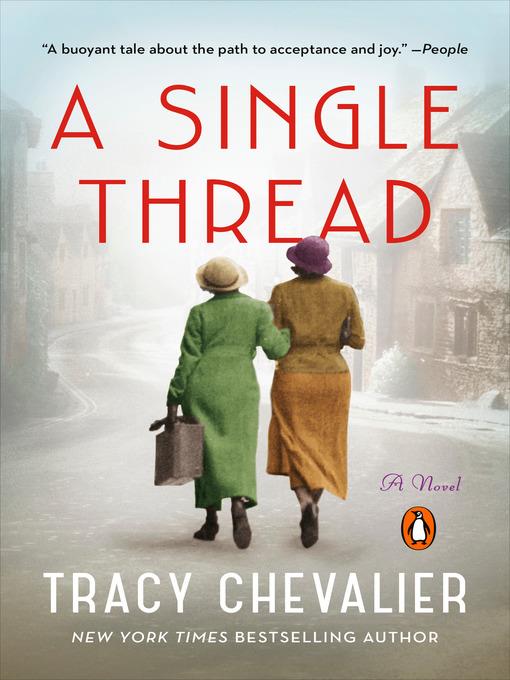
A Single Thread
A Novel
کتاب های مرتبط
- اطلاعات
- نقد و بررسی
- دیدگاه کاربران
نقد و بررسی

April 1, 2019
After her brother and fiancé are killed in the Great War, Violet Speedwell dreads staying home with her grief-wasted mother and moves to Winchester, England, where she finds companionship among the broderers--women who embroider the kneelers for the town's great cathedral, continuing a centuries-old tradition. Alas, the sense of self she discovers is threatened by social forces and a looming second war.
Copyright 2019 Library Journal, LLC Used with permission.

July 1, 2019
Chevalier (Girl with a Pearl Earring) celebrates the embroiderers of Winchester Cathedral in this appealing story of a 38-year-old spinster who learns needlecraft from real-life embroidery pioneer Louisa Pesel. In 1932, Violet Speedwell is what newspapers of the day call a surplus woman: unmarried and likely to remain so. Working as a typist in Winchester, Violet visits the cathedral, where she admires the intricate canvas embroidery on the kneelers, cushions, and other accessories. She joins the Winchester Cathedral Broderers Group and, after an unpromising start, becomes proficient under the mentorship of group founder Louisa Pesel. A fellow embroiderer introduces Violet to Arthur Knight, a 60-year-old married bell-ringer who, like Violet, has suffered the death of a loved one. Arthur protects Violet from a stalker and takes her to the bell tower to show her the ropes. Violet’s confidence grows as she learns to handle a needle, her mother, and her own desires. Chevalier excels at detailing the creative process, humanizing historical figures and capturing everyday life. With its bittersweet romance and gentle pace, Chevalier’s latest may be less powerful than her best novels, but it vividly and meticulously shows how vision, teamwork, and persistence raise needlecraft from routine stitching to an inspirational and liberating art.

July 15, 2019
It's been 14 years since the Great War ended, and Violet Speedwell is still grieving the loss of her brother and her fiance. A daring move--living on her own--will bring her a chance to breathe and love again. Of course, life as an independent woman in 1932 is hard. A typist for Southern Counties Insurance, Violet barely makes enough money to cover her rent at Mrs. Harvey's boardinghouse. Budgeting for one hot dinner a week and subsisting on margarine and Marmite sandwiches leaves Violet practically starving. She's emotionally starving, too. Chevalier (New Boy, 2017, etc.) masterfully portrays the bleak lives of the "surplus women" left to carry on after a generation of young men--their potential husbands--were killed in World War I. Telling the tale of the Lost Generation from a woman's perspective, Chevalier fills in the outlines of these forgotten women with unending penny-pinching, mended dresses, and lonely evenings with tea and a Trollope novel. Yet a chance glimpse into a special service at her church opens the door to Violet's healing: She finds the broderers, a group of women embroidering gorgeous, colorful seats and kneelers for the church. Led by the vibrant Louisa Pesel (and her dour assistant, Mrs. Biggins), the broderers' guild offers Violet a chance to make something beautiful and lasting in a world that has been dark and has cut off life at its knees for too long. In Chevalier's novel, the embroidery circle becomes a metaphorical tapestry, threading all these women together. Soon Violet has not only joined the circle, but also made unexpected friends. Violet also discovers her own courage to try for love, a love her society would condemn, but in these days and in this author's hands, all love is sacred. A compelling portrait of women not lost but thriving against the odds.
COPYRIGHT(2019) Kirkus Reviews, ALL RIGHTS RESERVED.

September 1, 2019
Violet Speedwell's life is not what she would have wished. The Great War took her fianc�, and now, in 1932, she's a 38-year-old surplus woman. Rather than martyr herself to caring for a toxic mother, Violet moves to Winchester to work. She joins the cathedral broderers, women whose needlework glorifies the church. She finds community and is soon drawn to one of the cathedral bell-ringers. Best-selling Chevalier presents women suffering spinsterhood as embarrassing at best, shameful at worst, to themselves and others. Violet's lack of a husband is her defining feature, conveying the difficulty of building an independent life as a meager salary keeps her threadbare, cold, and constantly hungry. She is pitied and disregarded, and even female friendships, including with a lesbian couple, are problematic. Chevalier's appealing characterization of similarly unwed yet indomitable Louisa Pesel, world traveler and first president of the Embroiderers' Guild of England, provides a marked contrast in contentment and purpose. Chevalier is strongest when describing artistic pursuits, from stitchery to ringing church bells, and that is where the novel both educates and engrosses.(Reprinted with permission of Booklist, copyright 2019, American Library Association.)

























دیدگاه کاربران